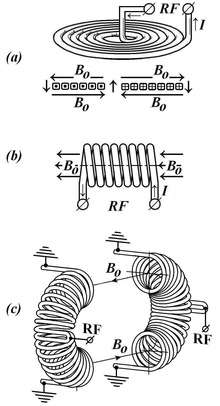Inductively coupled plasma

An inductively coupled plasma (ICP) or transformer coupled plasma (TCP)[1] is a type of plasma source in which the energy is supplied by electric currents which are produced by electromagnetic induction, that is, by time-varying magnetic fields.[2]
Operation
There are three types of ICP geometries: planar (Fig. 2 (a)), cylindrical [3] (Fig. 2 (b)), and half-toroidal (Fig. 2 (c)).[4]

In planar geometry, the electrode is a length of flat metal wound like a spiral (or coil). In cylindrical geometry, it is like a helical spring. In half-toroidal geometry, it is toroidal solenoid cut along its main diameter to two equal halves.
When a time-varying electric current is passed through the coil, it creates a time-varying magnetic field around it, which in turn induces azimuthal electric field in the rarefied gas, leading to the formation of the figure-8 electron trajectories[4] providing a plasma generation (see Hamilton-Jacobi equation in electromagnetic fields). Argon is one example of a commonly used rarefied gas.
Applications
Plasma electron temperatures can range between ~6 000 K and ~10 000 K (~6 eV - ~100 eV),[4] comparable to the surface of the sun. ICP discharges are of relatively high electron density, on the order of 1015 cm−3. As a result, ICP discharges have wide applications where a high-density plasma (HDP) is needed.
- ICP-AES, a type of atomic emission spectroscopy.
- ICP-MS, a type of mass spectrometry.
- ICP-RIE, a type of reactive-ion etching.
- Exciting a beam of noble gas to the metastable state.[5]
Another benefit of ICP discharges is that they are relatively free of contamination because the electrodes are completely outside the reaction chamber. By contrast, in a capacitively coupled plasma (CCP), the electrodes are often placed inside the reactor and are thus exposed to the plasma and subsequent reactive chemical species.
See also
- Pulsed inductive thruster
- Induction plasma technology
- List of plasma (physics) articles
- Capacitively coupled plasma
References
- ↑ High density fluorocarbon etching of silicon in an inductively coupled plasma: Mechanism of etching through a thick steady state fluorocarbon layer T. E. F. M. Standaert, M. Schaepkens, N. R. Rueger, P. G. M. Sebel, and G. S. Oehrleinc
- ↑ A. Montaser and D. W. Golightly, eds. (1992). Inductively Coupled Plasmas in Analytical Atomic Spectrometry. VCH Publishers, Inc., New York,.
- ↑ Pascal Chambert and Nicholas Braithwaite (2011). "Physics of Radio-Frequency Plasmas". Cambridge University Press, Cambridge: 219–259. ISBN 978-0521-76300-4.
- 1 2 3 Shun'ko, Evgeny V.; Stevenson, David E.; Belkin, Veniamin S. (2014). "Inductively Coupling Plasma Reactor With Plasma Electron Energy Controllable in the Range From ~6 to ~100 eV". IEEE Transactions on Plasma Science. 42 (3): 774–785. Bibcode:2014ITPS...42..774S. doi:10.1109/TPS.2014.2299954. ISSN 0093-3813.
- ↑ Ben Ohayon, Erik Wahlin and Guy Ron (2015). "Characterization of a metastable neon beam extracted from a commercial RF ion source". 10 (03). Journal of Instrumentation, Cambridge: P03009. arXiv:1502.05376
 . Bibcode:2015JInst..10P3009O. doi:10.1088/1748-0221/10/03/P03009.
. Bibcode:2015JInst..10P3009O. doi:10.1088/1748-0221/10/03/P03009.